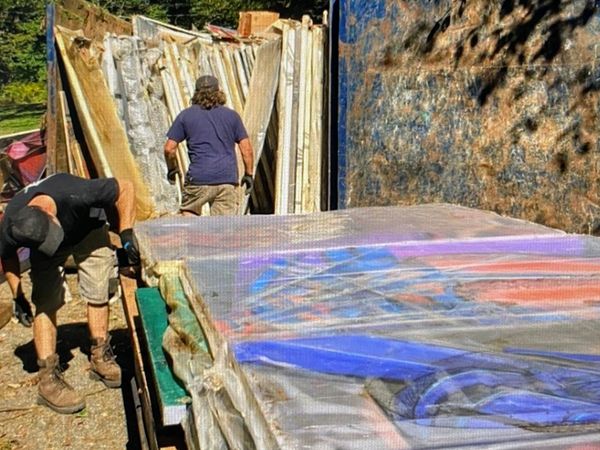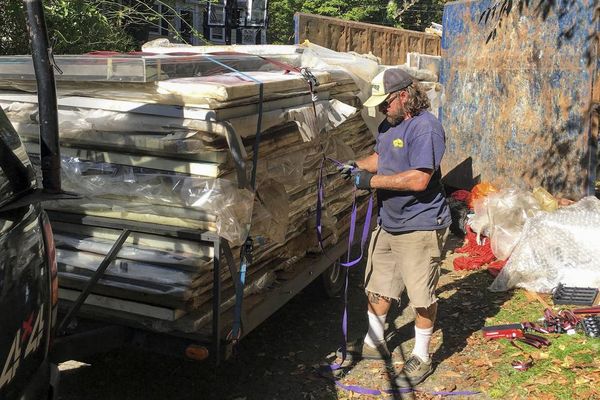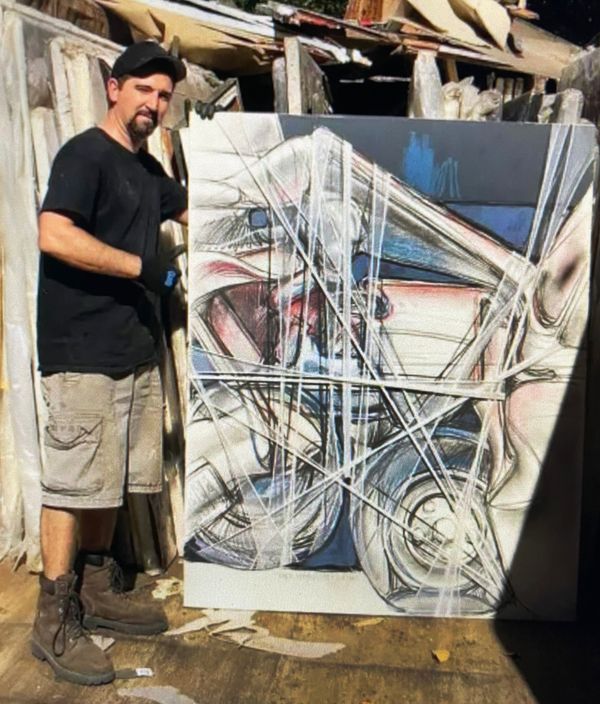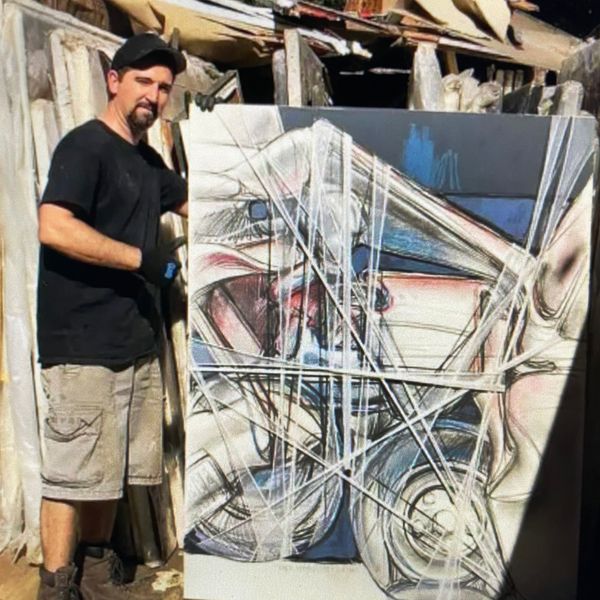(Subscribe to The Brass File to get it e-mailed free to your in-box by clicking on the link at the bottom of this page. After subscribing check your Spam/Promotions folder the first few times as sometimes the bots think we’re trying to spam you.)
Story By John Murray
Two thousand years ago Roman philosopher Seneca said, “Luck is what happens when preparation meets opportunity.”
Seneca would describe Jared Whipple as a lucky man.
Whipple has lived in the Brooklyn section of Waterbury, Connecticut, for the past 22 years. He’s been an automotive mechanic, an entrepreneur, a skateboard enthusiast, and for the past 15 years Whipple has maintained Catholic church buildings throughout Waterbury. Whipple is 40 years old, married, and describes himself as a hard working man with a passion for Harley Davidson motorcycles. Whipple loves Waterbury, and in many ways Jared Whipple represents the blue collar city known for its grittiness and perseverance.

Jared Whipple in front of St. Anne’s Church in Waterbury, CT |
In the past month Whipple has been written up in Smithsonian Magazine, he was featured in a four and half minute segment on CBS Sunday Morning News, and this weekend he will be profiled in the New York Times. His is an improbable story that has captured imaginations across America, and the headlines and soundbites don’t capture a holistic understanding of the weeks, months and years that were invested to create his breakout moment.
On April 10th, The Guardian headline said, “Connecticut mechanic finds art worth millions in dumpster at abandoned barn.” That same day Time Magazine’s headline said, “Mechanic Finds Art Worth Millions in Connecticut Dumpster”. World Today News wrote, “Paintings worth millions of dollars found in dumpster.”
“I didn’t really like a lot of those headlines,” Whipple said. “It made it seem like I’d won the lottery and overnight I was a millionaire. There is a lot more to the story.”
Every story has a beginning, so let’s get at it.
Whipple spent the first 18 years of his life in Beacon Falls and Naugatuck, and graduated from Naugatuck High School. Jared loved tinkering with cars and got a job at Artie’s Auto Body in Wolcott. He bounced around a few shops before opening his own business, Do It All Auto, in the Brooklyn section of Waterbury. Whipple ran that business for seven years. In 2007 Whipple saw a small ad in a newspaper announcing that St. Anne’s Church in Waterbury was looking for a part-time maintenance man. Whipple’s family is French-Canadian and had roots at St. Anne’s parish that went back 100 years. He applied for the job and was hired.
St. Anne’s had two 170-foot high granite spires that were an iconic part of the Waterbury skyline, and for more than a decade Jared Whipple was the only person to climb up inside the spires to inspect them.
“I climbed up there when it was raining,” Whipple said, “that was the time to check for leaks.”
The inside of the spires were constructed with two layers of red brick, with granite rock on the outside. “The red brick began crumbling and I reported about it for years,” Whipple said. “I saw it with my own eyes.”
Despite strong emotional opposition from the community, the spires were dismantled in 2019 for safety reasons, and Whipple was devastated. “This church was an iconic building in the city,” he said. “People used to pull off the highway every day to take pictures of it and to look at the church. Now, very few people come around.”

The spires at St. Anne’s Church in Waterbury, CT. |
When the spires were removed every stone was labeled and categorized and they are being stored in a geographic grid in the hopes money is raised to rebuild them.
“It’s a giant puzzle and there are plans to begin fundraising to put them back up,” Whipple said. “It may take 5 or 10 years, I don’t know, but it ripped my heart out when we took them down.”
The spire tale is a story within a story, but it provides clues to Jared Whipple’s reverance for history, a passion that led him towards his fateful discovery in the abandoned Watertown barn.
The call came on September 22, 2017. A friend’s company had been hired to clean out an old barn and Jared was invited to see if there was anything that might interest him. He hoped to find automotive parts and was delighted to find a never-used 1975 Sunfish sailboat that was made in Waterbury. Jared went to the barn with his friend George Martin and George’s son, Logan. George is well known in the area for his incredible Halloween displays that annually attract 3000 trick or treaters to his home on Millville Street in Naugatuck.
When they saw a giant 40-yard dumpster stuffed with dozens of oversized paintings they were confused. The paintings were heavily wrapped in plastic and they decided to open some up and take a look.

Jared Whipple and George Martin processing their discovery. |
“Our first thought was we could use them for George’s Halloween display,” Whipple said, “but the closer we looked we realized the high quality of the art and it seemed like someone’s entire collection of work was heading to the landfill.”
As he inspected the paintings Whipple was stunned to see that the artist used images of car parts in his work, further exciting Whipple, who decided he need to save this collection. Several artists had been contacted previously to look at the collection before Whipple, but they hadn’t recognized the work, and had no place to store the sheer volume of space the collection would consume.

George Martin loaded up part of the collection to transport to Waterbury. |
Several years before Whipple had built a 6000 square foot private indoor skateboard park in the Brooklyn section of Waterbury, and it took many trips and a lot of sweat, but Whipple and his friends managed to transport the entire art collection from the dumpster to his skateboard park. They saw that the paintings were all signed F. Hines, but extensive Google searches came up empty. Who was F. Hines?

Francis Mattson Hines |
Eventually Whipple found one painting signed Francis Mattson Hines, and Google recognized that name immediately. Hines was recognized as the artist who wrapped the Washington Square Arch in New York in 8,000 yards of polyester fabric, an event that was rated one of the top ten most important public art events in New York history. A picture of the event showed the bridge had been wrapped is the same fabric that all the paintings in the dumpster were wrapped with as well. Every painting was individually wrapped in plastic and fabric and covered in mold, dirt, dust, roofing debris, and animal feces.

The Washington Square Arch in New York wrapped in 8,000 yards of polyester fabric. |
Hines had a stroke in 2014 and died in 2016 at the age of 96. He lived in New York City and stored the majority of his artwork in the barn in Watertown. According to Peter Hastings Falk in Discoveries In American Arts, “the barn where Hines had stored his artwork was being sold and his estate had to comply with a tight deadline that was imposed for cleaning out the barn’s contents; the contents of the barn were deemed abandoned and a contractor was assigned to clear out the contents.”
That’s when Jared Whipple entered the scene.

Jared Whipple standing in the dumpster with a Fancis Hines painting. |
Now that they knew who the artist was, Whipple believed the collection was created by a true master and should be treated with dignity and respect. Working closely with his uncle, Whipple spent the next several months categorizing the entire collection that included paintings, drawings, and sculptures by Hines. They carefully unwrapped each piece, hung it on a wall, photographed it, measured it, catalogued it, and then rewrapped every painting and sculpture.
To protect the artwork, Whipple and George Martin overhauled the building with roof repairs, new gutters and drain pipes. Once the building was completely buttoned up and the entire collection was organized, cataloged, and put into storage, Whipple began a deep dive into Francis Mattson Hines. Whipple contacted the artist’s family, his friends and anyone that had exhibited his work in the past.
“Whoever I talked to said the same thing,” Whipple said. “Francis was an incredible artist who created fascinating works but, unfortunately, he was now completely unknown to the contemporary art world.”
Hines had busied himself making his art, not selling and marketing it and building a reputation.
In an introduction to Wilderness by Rockwell Kent in 1920, Dorothy Canfield wrote, “Art to the artist, and art to the rest of us, are two very different things. Art to the artist is quite simply Life, his life, of which he has an amplitude and intensity unknown to us.”
Hines had been focused on the process of creating, but that made it more difficult for Whipple to bring light to his collection. For months Whipple ran into dead ends until he made contact with a retired art dealer from San Francisco named Muldoon Elder. Muldoon was the owner of Vorpal Gallery located in New York City and San Francisco, and had exhibited Hines’ work during the mid 1980s. Muldoon confirmed that Francis Hines was a master who created very powerful works but, unfortunately, chose to fly under the radar.
Elder connected Whipple to Peter Hastings Falk, an art historian, and Falk drove to Waterbury to check out the collection. The goal became to establish Francis Hines as a significant artist of the 20th and 21st centuries, and it would begin by exhibitions and sharing Hines’ and Whipple’s stories. The whole process has taking Jared Whipple four and half years, hundreds of hours of work, and money out of his own pocket.
The first exhibition was at the Matttatuck Museum in Waterbury in September 2021, but Whipple said the local Waterbury angle was downplayed and the collection didn’t garner much attention.
In April 2022 the story made an international splash when Whipple took center stage as headlines blared, “Mechanic Discovers Art Worth Millions In Dumpster.” The story was picked up in newspapers all across North America and Europe.
“The human interest angle really made the story take off,” Whipple said. “While I’m not crazy about the headlines, in a way it’s been very good for the artwork of Francis Hines.”
And it might turn out very well for Jared Whipple, the hard working Waterbury man who loved cars and history, and was now transforming into an art curator making an international splash. The Hines Family has given Whipple permission to sell the artwork – valued at several million dollars – and keep all the proceeds for himself.
While that sounds like a fantasy ending, Whipple doesn’t see it that way. “This is going to take years to clean and restore and sell these pieces,” Whipple said. “Maybe I can sell one or two pieces a year and make a salary from the collection. Maybe I have a career change, I’m not sure, but I don’t ever plan on leaving St. Anne’s Church. It’s too important to me and there is so much work to do.”
And with that, Jared Whipple ended our interview to find the roofing contractor he was expecting to begin another major project on his beloved St. Anne’s Church.
Jared Whipple is a lucky man. •
- Five pieces of Francis Hines art will be on exhibit April 22 to June 15 at the Mattatuck Museum in in downtown Waterbury.
- An exhibit of the found art will open May 5 at the Hollis Taggart galley in Southport, Connecticut, which is known for showing the works of lost or forgotten artists. A smaller exhibit will be shown simultaneously at the gallery’s flagship location in New York City.

